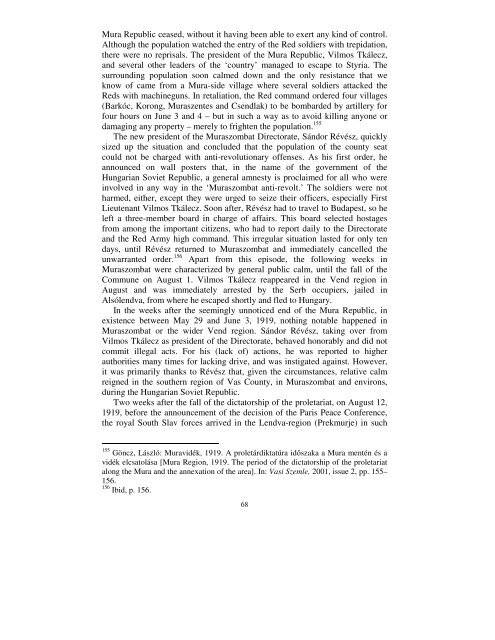The Fate of Western Hungary 1918-1921 - Corvinus Library ...
The Fate of Western Hungary 1918-1921 - Corvinus Library ...
The Fate of Western Hungary 1918-1921 - Corvinus Library ...
You also want an ePaper? Increase the reach of your titles
YUMPU automatically turns print PDFs into web optimized ePapers that Google loves.
Mura Republic ceased, without it having been able to exert any kind <strong>of</strong> control.<br />
Although the population watched the entry <strong>of</strong> the Red soldiers with trepidation,<br />
there were no reprisals. <strong>The</strong> president <strong>of</strong> the Mura Republic, Vilmos Tkálecz,<br />
and several other leaders <strong>of</strong> the ‘country’ managed to escape to Styria. <strong>The</strong><br />
surrounding population soon calmed down and the only resistance that we<br />
know <strong>of</strong> came from a Mura-side village where several soldiers attacked the<br />
Reds with machineguns. In retaliation, the Red command ordered four villages<br />
(Barkóc, Korong, Muraszentes and Csendlak) to be bombarded by artillery for<br />
four hours on June 3 and 4 – but in such a way as to avoid killing anyone or<br />
damaging any property – merely to frighten the population. 155<br />
<strong>The</strong> new president <strong>of</strong> the Muraszombat Directorate, Sándor Révész, quickly<br />
sized up the situation and concluded that the population <strong>of</strong> the county seat<br />
could not be charged with anti-revolutionary <strong>of</strong>fenses. As his first order, he<br />
announced on wall posters that, in the name <strong>of</strong> the government <strong>of</strong> the<br />
Hungarian Soviet Republic, a general amnesty is proclaimed for all who were<br />
involved in any way in the ‘Muraszombat anti-revolt.’ <strong>The</strong> soldiers were not<br />
harmed, either, except they were urged to seize their <strong>of</strong>ficers, especially First<br />
Lieutenant Vilmos Tkálecz. Soon after, Révész had to travel to Budapest, so he<br />
left a three-member board in charge <strong>of</strong> affairs. This board selected hostages<br />
from among the important citizens, who had to report daily to the Directorate<br />
and the Red Army high command. This irregular situation lasted for only ten<br />
days, until Révész returned to Muraszombat and immediately cancelled the<br />
unwarranted order. 156 Apart from this episode, the following weeks in<br />
Muraszombat were characterized by general public calm, until the fall <strong>of</strong> the<br />
Commune on August 1. Vilmos Tkálecz reappeared in the Vend region in<br />
August and was immediately arrested by the Serb occupiers, jailed in<br />
Alsólendva, from where he escaped shortly and fled to <strong>Hungary</strong>.<br />
In the weeks after the seemingly unnoticed end <strong>of</strong> the Mura Republic, in<br />
existence between May 29 and June 3, 1919, nothing notable happened in<br />
Muraszombat or the wider Vend region. Sándor Révész, taking over from<br />
Vilmos Tkálecz as president <strong>of</strong> the Directorate, behaved honorably and did not<br />
commit illegal acts. For his (lack <strong>of</strong>) actions, he was reported to higher<br />
authorities many times for lacking drive, and was instigated against. However,<br />
it was primarily thanks to Révész that, given the circumstances, relative calm<br />
reigned in the southern region <strong>of</strong> Vas County, in Muraszombat and environs,<br />
during the Hungarian Soviet Republic.<br />
Two weeks after the fall <strong>of</strong> the dictatorship <strong>of</strong> the proletariat, on August 12,<br />
1919, before the announcement <strong>of</strong> the decision <strong>of</strong> the Paris Peace Conference,<br />
the royal South Slav forces arrived in the Lendva-region (Prekmurje) in such<br />
155 Göncz, László: Muravidék, 1919. A proletárdiktatúra időszaka a Mura mentén és a<br />
vidék elcsatolása [Mura Region, 1919. <strong>The</strong> period <strong>of</strong> the dictatorship <strong>of</strong> the proletariat<br />
along the Mura and the annexation <strong>of</strong> the area]. In: Vasi Szemle, 2001, issue 2, pp. 155–<br />
156.<br />
156 Ibid, p. 156.<br />
68
















